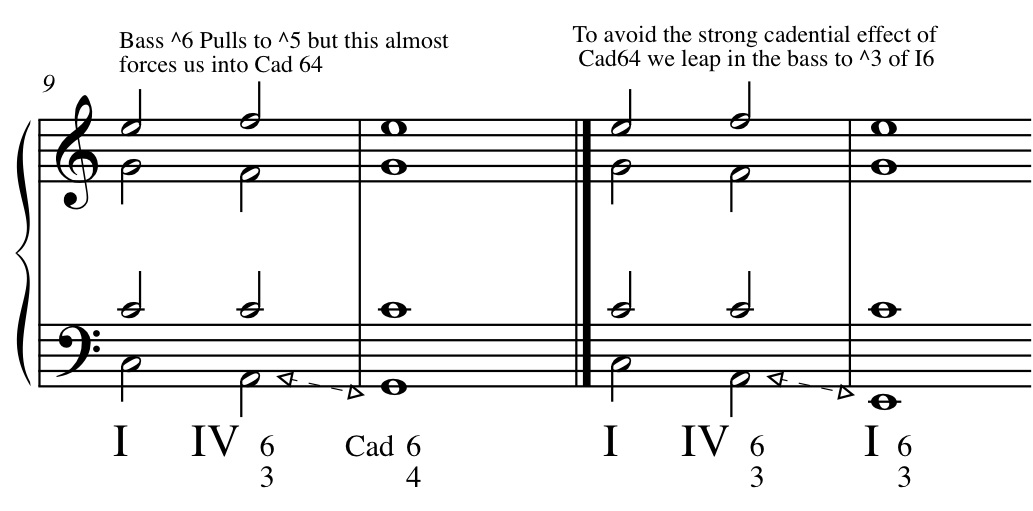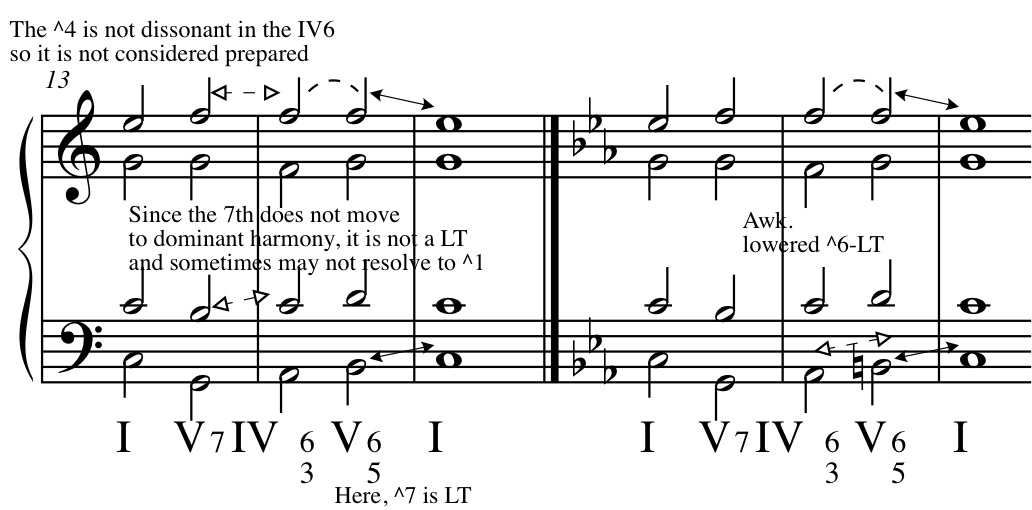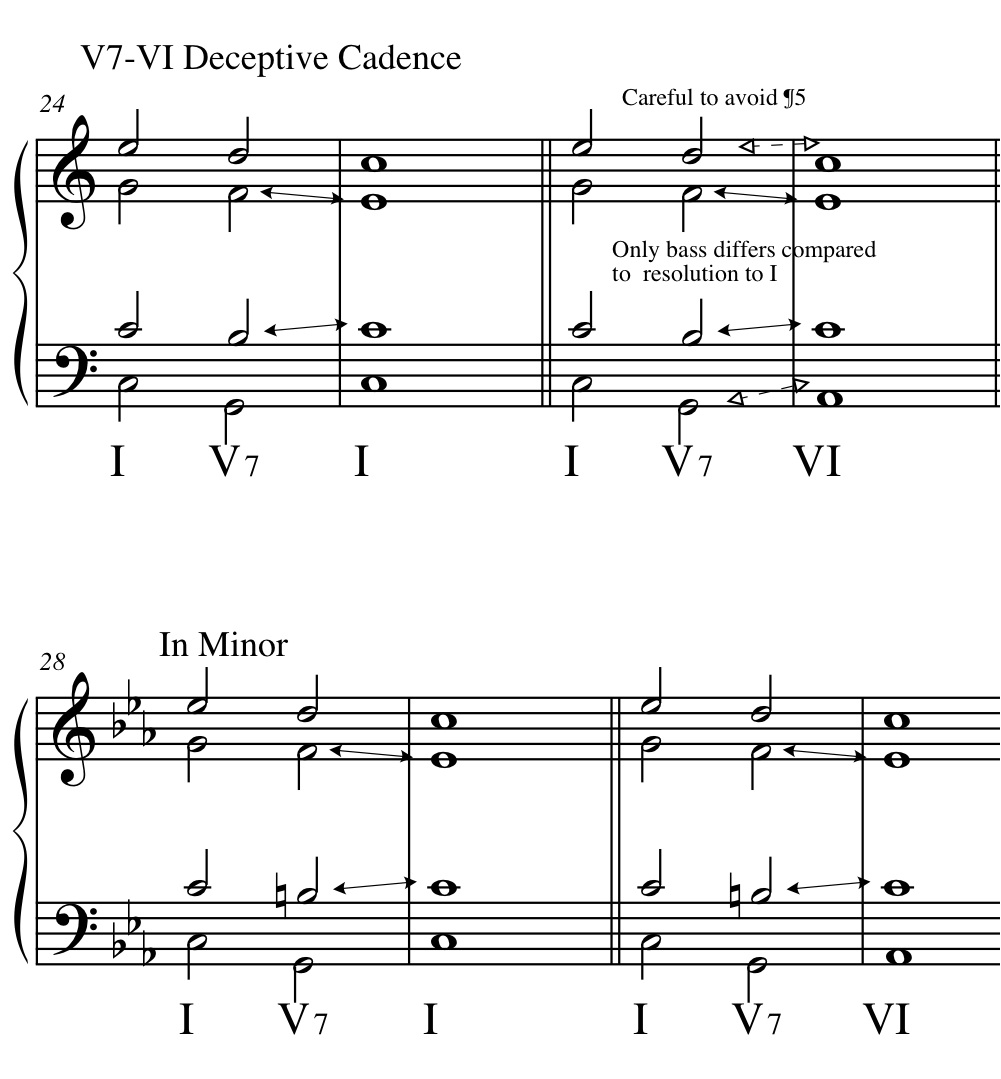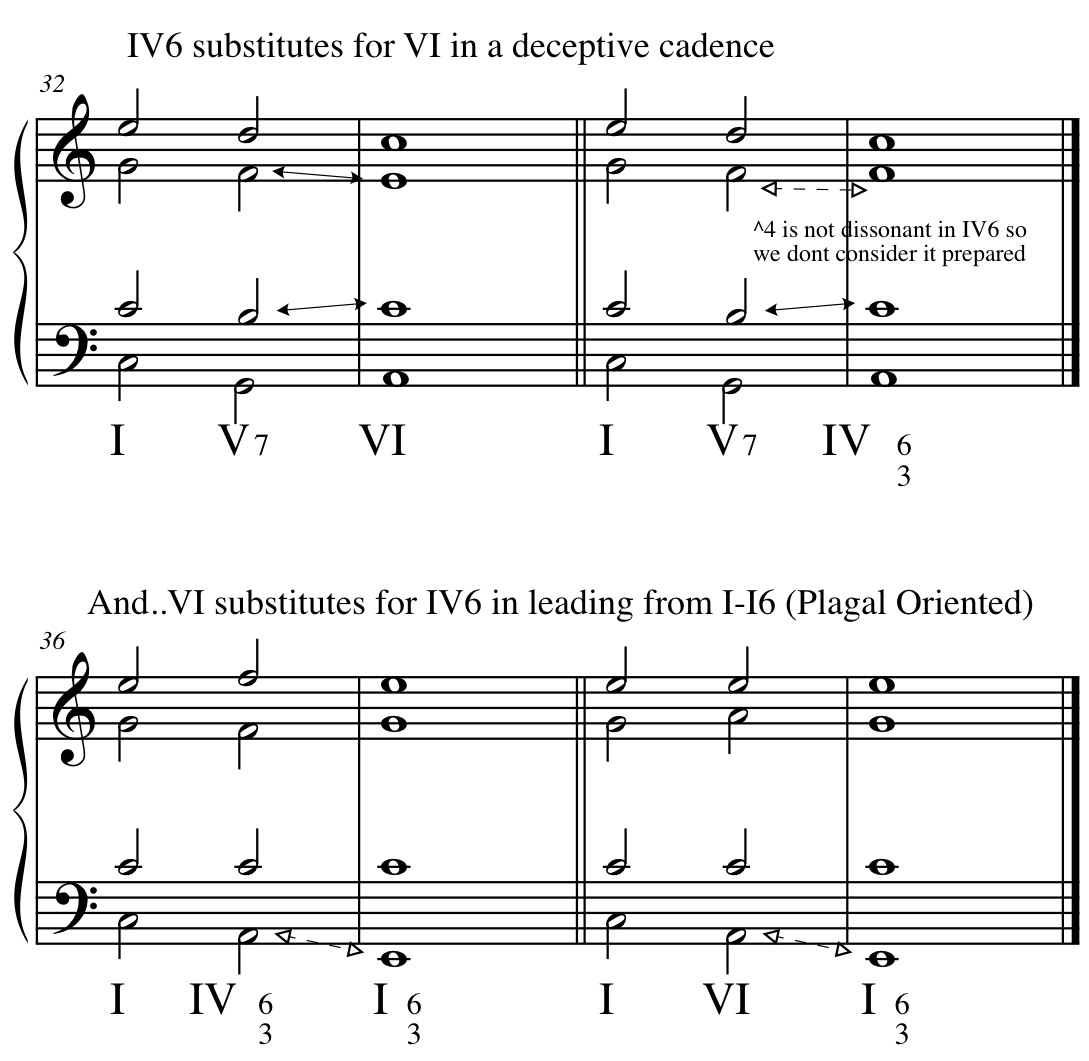Homework: Workbook Chapter 13 Ed 3 pg 89-93 & pg
96-99 #s 1,3,4,6
Homework: Workbook Chapter 14 Ed 4 pg 101-102 , 104#2,
105 #3, 106#5, 108-109 #s 2,3,4
OR
Workbook Chapter 13 pg 90-92 AND
Write the following 3 short compositions: Submit a pdf of your Finale notation score and n mp3 of a piano rendering to musictheory2@gmail.com. You may also render your compositions using strings from the garritan library included with Finale.
1. In Major: 8 bars all half notes in 4 voices that contain the following useages:
1, Plagal Cadence
2. IV6 - Cad64
3. "PIV6"
2. In Minor: 8 bars all half notes in 4 voices that contain the following useages:
1, Plagal Cadence
2. IV6 - I6
3. Deceptive Cadence
3. In major or minor write the following syntax. Focus on harmonic rhythm. You must use 4 voice harmony at all times but may vary the rhythm beyond constant half notes. Only use two successive half notes once in this assignment. You may use quarter notes and whole notes as well.
1. I-VI-II65-cad64-V42-I6-IV65-V7-"PIV6"-V65-I-IV-I
2. Having written the above progression with an interesting harmonic rhythm, rewrite your soprano voice to enhance your melodic statement.
So far, we have seen that the function of IV, IV6 and VI is to act as intermediary harmonies that lead us away from one, form and expansion with II, II6, II7 (+inv) and lead towards cadential V, V6, V7(+inv) , Vii6 and Cad64. In this chapter we will see that IV, IV6 and VI can act not only as intermediary harmonies but as cadential elements as well.
IV and IV6
1. I-IV-I: Expanding tonic harmony
a. The strong gravitational pull of the P5 in the dominant Vsecurely establishes a key area and has been the cornerstone of our cadential discussions. Since we have stated that there is a close relationship between an interval and its inversion it stands to reason that the P4 could also have a cadential pull in and of itself. To be sure the progression I-IV-I constitutes an important source of cadential variety and contrast. Since the IV is built on ^4 it is distictly subordinate to the cadential I-V-I progression.
b. IV can be a cadential element with either I or I6
2. Plagal Cadences
a. When IV-I is used as a cadential element, it is called a Plagal Cadence.
b. Since the IV does not contain the LT, this type of cadence has a much more limited cadential effect.
insert 13-1-2


3. 1-IV6-I6
a. As stated above, the bass of a I-IV-I progression will have a cadential effect. To soften this effect, we can move to IV6 with the bass on ^6.
b. Since the ^6 has a tendancy to move towards ^5 in both major and minor, the resultant I-IV6 progression would yield a Cadential 64 propelling us very strongly to V.
c. To avoid the Cadential 64 that would follow the I-IV6 motion, we resolve the ^6 not to the ^5 but leap to the ^3 of a I6.
d. Please note: H&VL makes a subtle but important point: Since ^6 wants to resolve to ^5, H&VL implies that the only acceptible resolution of the ^6 that avoids a cad64 is to move the bass down to ^3 of I6. The reason is this: By moving the bass below ^5 we implicitly hear the ^5 even if it does not exist. (its a similar idea to moving the LT to ^5 instead of ^1) Thus if we jump up to a I6 we leave the ^6 unresolved. If we jump down to the ^1 of I5, the leap creates a disruptive bass line. Without a doubt, you should understand this point as it again demonstrates the peculiartiy of the ^6 (remember the struggles with ^6 voiceleading in the IV7-V progression) It is very important that you learn the sound associated with this implication. I personally like repose presented by the ^6 of the IV6 leaping up to the ^3 of a I6 but I also fully understand the implications of the missing resolution to ^5.
Insert 12-3

4. IV6 as a passing chord within V
a. Not only can IV6 be used to expand I, but it can be used to expand a V-V6 (65) progression. When mvoing from IV6 to V6(65) we see the ^6 resolve up to the leading tone. This immediate motion towards the strong pull of the LT makes the upward resolution of ^6 more acceptible.
b. H&VL does not state, but it is important to realize that in minor the movement from the lowered ^6 of a IV6 to the LT of a V6 yields an awkward A2 in the bass and, for now, should be avoided unless the ^6 is raised as would be the case in melodic minor.

VI
5. VI as a substitute for I
a. We have seen that II & IV share two tones (^4 & ^6) and therefore can be used interchangeably in many situations. We have also seen IV & VI share two tones (^6 & ^1) and also can be used interchangeably in many situations. Thus it stands to reason I and VI which also share two tones (^I & ^3) can be used interchangeably in some situations . In fact since the two tones that most strongly identify the tonic chord are the ^1 aad ^3 we can think of another function of VI (which contains ^1 & ^3) as a substitute for I.
6. Deceptive Cadence
a. If a substitution of VI occurs where a cadence is expected, we call the progression a deceptive cadence. Since the VI chord also serves as an intermediary harmony, the use of the deceptive cadence can, in turn, lead to an expansion of intermediary harmony thereby delaying and creating a hightened sense of anticipation of the cadential effect.

7. IV6 & VI
a. Since IV6 and VI are so closely related, we sometimes see the IV6 substitute for VI in a deceptive cadence. In other words, the IV6 substitutes for the VI which, in turn, substitues for the I
b. Similarly, we sometimes see VI substitute for IV6 in the plagally oriented progressiom I-IV6-I6

A Final Word from Prof Andy
a. The idea of substitution is prominant and common in music. Since any two chords a third apart share two common tones, their relationship to one another will be close. It is very important, however, to realize that the effect of the substitution is almost always less profound than that of the original progression. The deceptive cadence V-VI has a closer cadential effect than that of V-IV6. Substitutions are OK if, and only if, you realize that the substitution is reducing the effect of the original progression.
b. As we begin the conclusion of our study of the role of the individual chordal functions and proceed to look at the compositional function of chordal progressions H&VL leaves us with some very wise words.... "Textbook patterns will sometimes appear in a composition. But the meaning-the inner grouping and the relation to larger context- will depend largely on the individual character of the passage"
|

